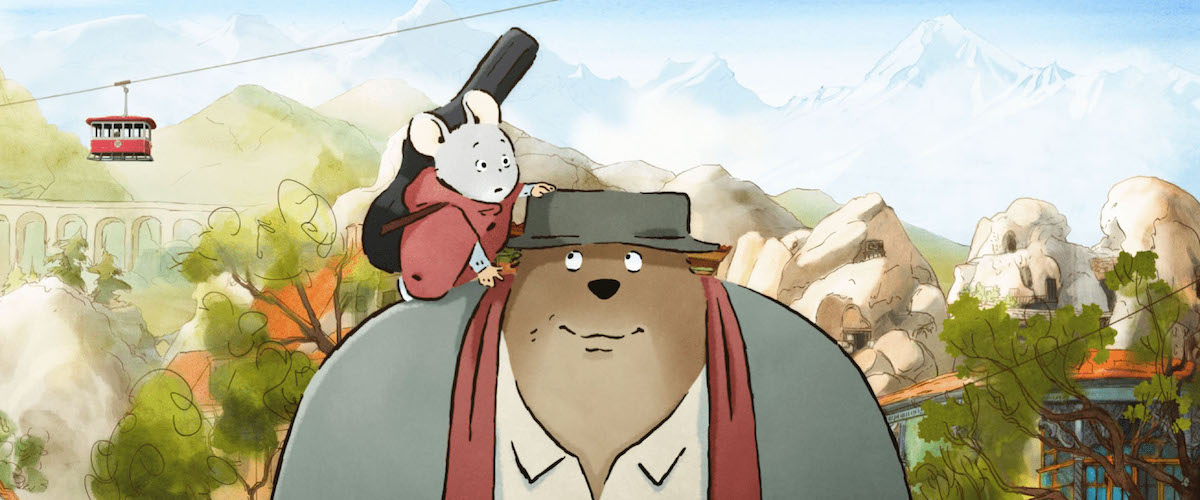“Ernest & Celestine: A Trip to Gibberitia,” an animated film co-directed by Julien Chheng and Jean-Christophe Roger and the sequel to the Oscar-nominated “Ernest & Celestine” (2012), starts sweet and charming, a slice-of-life story in the friendship between Ernest, a cranky old bear, and Celestine, a positive-thinking innocent mouse. Adapted from the children’s books by Gabrielle Vincent, both films center on this improbable friendship. The charming shenanigans they get up to are embedded with resonant kid-friendly messages: what it’s like to feel like an outsider, how bad it feels when the world judges you, and how important it is to have friends. Anything is bearable (pun intended) if you have a good friend. The sequel takes this a step further.
It opens with Ernest (voiced by Lambert Wilson) sleeping in bed, coming to the end of his hibernation period, and having a dream. The dream is a Utopia at first: Ernest plays his violin, surrounded by a happy crowd. In a flash, the mood changes: the music is now discordant. Ernest spirals down through empty space, all as a massive judge’s gavel bangs its terrifying verdict: “GUILTY.” Ernest wakes, panting with fear about his nightmare. Or was it a flashback? What happened to the music? Why did Ernest’s dream utopia morph into a Kafka-style vision?
Philosophical questions will have to wait. Ernest is hungry. Ernest is a woe-is-me pessimist, and Celestine (Pauline Brunner) is a can-do optimist. The animation is soft and hand-drawn like charming sketches come to fluid life. The colors at first are soft: light greens and soft pinks. Ernest and Celestine live in a recognizable suburban world of small back gardens and little row houses. These colors will change and deepen, and new shadows, darker and more complicated, will be added to the palate.
Disaster strikes early on when Celestine accidentally breaks Ernest’s violin (a “Stradibearius”). Ernest is in despair: The only bear who can fix it is the bear who built it, Octavius, but Octavius lives far away in Gibberitia, Ernest’s home country. What is to be done? bemoans Ernest. Celestine suggests traveling to Gibberitia, a proposal Ernest sternly rejects. At first, it is not clear why. Though tormented by guilt, Celestine sets out on her own, clutching the violin in its case. Ernest, when he discovers her absence, sets off in pursuit. His horror at Celestine’s actions seems a bit out-sized. Why is he so terrified at the thought of her going to Gibberitia? We soon find out why.
Turns out, Gibberitia is a beautiful place with grassy streets, and everything looks golden and peaceful. But Celestine notices some strange things with the eyes of a newcomer. Birds chirp in the trees, and policemen race over with fire hoses, blasting them to the wind with water. People dress strangely; children wear exactly what their parents wear. There are random stoplights at certain corners, even though there’s no traffic, and when they flash red, the entire populace freezes in its tracks like statues. The courthouse is in the shape of a massive gavel. It’s clear Gibberitia’s “peace” is imposed by fiat. In Gibberitia, anything other than one-note music is forbidden. Melody is forbidden. An old bear plays a piano in the park, banging on one note repeatedly. Gibberitia’s motto is the depressing fatalistic: “That’s just how it is.”
Celestine, true to her “can-do” self, is determined to find the Musical Resistance. There’s got to be one, right? You can’t just ban music! People will continue to love music, gigantic judge’s gavel be damned! Meanwhile, Ernest gets sucked into the familial drama, which leads to him fleeing in the first place.
This all sounds like very serious business, and it is: the political critique is pointed and very well done. It’s not too heavy-handed, but the empty streets are eerie, especially the huge musical notes painted on alley walls as secret signals of solidarity. For children, the message is relevant to their young lives. There’s a lot here about feeling like you’re not part of the “in” group, of feeling misunderstood by your parents, of feeling the burden of expectations. In Gibberitia, sons do what their fathers do. You can’t just decide to be a musician! It’s unheard of!
“Ernest and Celestine” also evokes the dislocation of immigrants and refugees. Ernest knows what Gibberitia is like. There’s a reason he left. Yet he yearns for the sense of belonging only home can give. He has the lonely, longing heart of one in permanent exile.
The friendship between bear and mouse is truly touching and where the film’s real heart beats. Ernest and Celestine are so different. Ernest is old; Celestine is young. Ernest always ready to throw in the towel; Celestine is open to all possibilities. The two embody William Blake’s Songs of Innocence and Songs of Experience. Celestine’s innocence is important, and Ernest’s experience is, too. They come together, though, in tenderness and understanding. It’s beautiful.
Now playing in theaters.




















